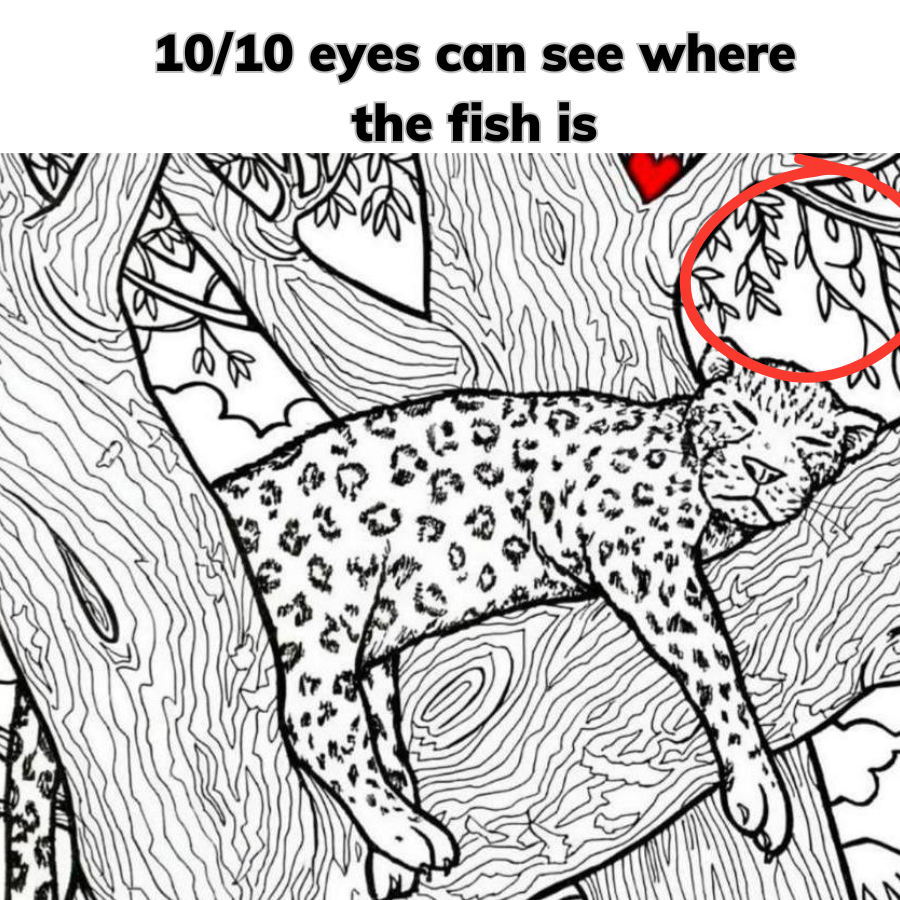In this visual puzzle, a simple task is presented: find the fish in the image. At first glance, it may seem easy, but many people struggle to locate it. Optical illusions like this one often trick the brain, which processes visual information in fascinating ways. Let’s dive deeper into why such puzzles are so challenging and how our brain works when trying to solve them.
Why Optical Illusions and Visual Puzzles Fascinate Us
Optical illusions play with our perception by manipulating the way light, shapes, and patterns interact. In this case, the fish blends into the background, making it almost invisible to the casual observer. The key lies in understanding how the brain interprets information from the eyes. Our brain takes visual cues from the environment, fills in gaps, and makes assumptions based on past experiences.
According to neuroscientists, the human brain processes visual information very quickly. It interprets patterns, colors, and contrasts to form an image. But when images are ambiguous or intentionally misleading, like the fish puzzle, our brains get confused. This confusion can lead to fascinating insights into how the mind works.
The Power of Visual Perception
In optical illusions, like the one discussed, there’s often a disconnect between what our eyes see and what our brain interprets. Visual perception relies on several cognitive processes, including pattern recognition, depth perception, and color differentiation. When the fish blends into the background, it becomes harder for our brains to pick out. This is because we tend to focus on more prominent visual cues.
The ability to spot the hidden fish requires careful observation, as well as attention to detail. While some people might be able to spot it right away, others may struggle, revealing how differently our minds process visual stimuli. These puzzles test not only our eyesight but also how well we can focus and filter through distractions.

How Our Brain Trains Itself to See Patterns
Visual puzzles train the brain to sharpen focus and attention to detail. While many people might assume that good eyesight is all that’s required to solve these puzzles, there’s much more happening behind the scenes. The brain develops neural pathways based on repetition and familiarity. Over time, someone who frequently engages in such puzzles will become better at identifying hidden patterns quickly.
A study published in the journal Cognitive Research found that individuals who regularly engage with visual puzzles improve their visual search skills. This improvement is attributed to neuroplasticity, the brain’s ability to rewire itself based on experience. Essentially, the more you practice, the better you get at recognizing patterns and distinguishing objects in cluttered visual environments.
The Role of Cognitive Bias in Optical Illusions
Another factor that contributes to the difficulty of spotting the fish is cognitive bias. Cognitive bias refers to the brain’s tendency to make assumptions based on previous experiences and expectations. In puzzles like this, our brains may expect the fish to look a certain way or be in a particular spot, which leads us to overlook the actual location of the hidden object.
For example, if you’ve previously seen puzzles where the object is placed in the center of the image, your brain might automatically direct your attention there, even though the fish is elsewhere. This bias can lead to frustration, as you repeatedly overlook the solution even though it’s right in front of you.
Optical Puzzles and Visual Training in Daily Life
Surprisingly, visual puzzles like the fish illusion can have practical benefits in everyday life. Whether it’s training our brains to spot details or improving our ability to focus, regularly engaging in such challenges can enhance our cognitive abilities. This can be particularly helpful in professions that require sharp observation skills, such as detectives, surgeons, or even graphic designers.
Even outside professional settings, visual training can help us improve our memory, attention span, and reaction time. Studies have shown that regular engagement with puzzles and brain games can delay cognitive decline in older adults, demonstrating their long-term benefits.
Why Some People See It Right Away, and Others Don’t
If you’re wondering why some people can see the fish immediately while others struggle, the answer lies in how each individual’s brain processes visual stimuli. People with strong attention to detail or those who are more experienced with visual puzzles tend to spot the hidden object faster. In contrast, those who rely on cognitive shortcuts, like focusing only on larger or more obvious patterns, may take longer.
Additionally, factors like mood, stress levels, and even fatigue can impact how well we perform on visual puzzles. When we’re tired or stressed, our brains are less efficient at processing information, making it harder to focus and solve puzzles.
Conclusion
Optical illusions and visual puzzles like the one featuring the hidden fish are more than just fun distractions. They offer a window into the workings of the human brain, revealing how we process and interpret visual information. By challenging our minds with puzzles, we can sharpen our cognitive skills and gain a deeper understanding of how perception works. Whether you’re a seasoned puzzle solver or someone new to these challenges, the next time you encounter an optical illusion, you’ll have a better appreciation for the fascinating science behind it.

Comments are closed.